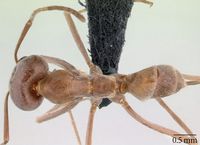Dorymyrmex amazonicus
| Dorymyrmex amazonicus | |
|---|---|

| |
| Scientific classification | |
| Kingdom: | Animalia |
| Phylum: | Arthropoda |
| Class: | Insecta |
| Order: | Hymenoptera |
| Family: | Formicidae |
| Subfamily: | Dolichoderinae |
| Tribe: | Leptomyrmecini |
| Genus: | Dorymyrmex |
| Species: | D. amazonicus |
| Binomial name | |
| Dorymyrmex amazonicus Cuezzo & Guerrero, 2011 | |
The type series was collected in the vicinity of an Amazonian forest relict, outside Leticia (Colombia). All the specimens were collected in open deforested habitat, probably this is an indication of the preference of this species to nest in highly anthropic or disturbed environments. (Cuezzo and Guerrero 2011)
Identification
Cuezzo and Guerrero (2011) - Worker. Large ant, TLI: 133–135. Head with lateral margins broadly convex and posterior margin of head concave medially. Short scape not surpassing the posterior margin of the head more than three times its apical width.
At first view, this species could be confused with Dorymyrmex brunneus, but a greater TLI, shorter scapes, eyes placed deep inside the head capsule, and a continuous mesosomal profile in D. amazonicus are the best characters to separate it from D. brunneus. Other Dorymyrmex species found in Colombia share with D. amazonicus the shape of mesonotal profile (i.e., D. pyramicus), but all the characters, given in the key and in the diagnosis above, are useful to separate D. amazonicus from other species of Dorymyrmex found in Colombia.
Keys including this Species
Distribution
Known only from the type collection - Amazonas, Colombia.
Latitudinal Distribution Pattern
Latitudinal Range: -4.218888889° to -4.218888889°.
| North Temperate |
North Subtropical |
Tropical | South Subtropical |
South Temperate |
- Source: AntMaps
Distribution based on Regional Taxon Lists
Neotropical Region: Colombia (type locality).
Distribution based on AntMaps
Distribution based on AntWeb specimens
Check data from AntWeb
Countries Occupied
| Number of countries occupied by this species based on AntWiki Regional Taxon Lists. In general, fewer countries occupied indicates a narrower range, while more countries indicates a more widespread species. |

|
Estimated Abundance
| Relative abundance based on number of AntMaps records per species (this species within the purple bar). Fewer records (to the left) indicates a less abundant/encountered species while more records (to the right) indicates more abundant/encountered species. |

|
Biology
Castes
Known only from the worker caste.
Nomenclature
The following information is derived from Barry Bolton's Online Catalogue of the Ants of the World.
- amazonicus. Dorymyrmex amazonicus Cuezzo & Guerrero, 2011: 5, figs. 1a-c, 13 (w) COLOMBIA.
Unless otherwise noted the text for the remainder of this section is reported from the publication that includes the original description.
Description
Worker
Holotype (Paratypes = 2). HL: 1.00 (1.02–1.04). HW: 0.92 (0.94–0.96). EL: 0.30 (0.28–0.30). EW: 0.22 (0.22). SL: 1.06 (1.06–1.08). WL: 1.32 (1.36–1.40). CI: 92 (92). SI: 106 (104). REL: 30 (27–29). OI: 73 (73–79). TLI: 132 (133–135).
Head and scapes reddish-brown; lateral clypeal region and dorsal face of mandibles testaceous yellow; masticatory mandibular margin dark brown; mesosoma, legs, petiole, and gaster yellowish-brown. Whitish, short, and appressed pubescence covering all the body tagma. Head: head slightly longer than wide, with lateral margins strongly convex and posterolateral corners rounded. Posterior margin of the head concave in the middle. Mandibles strongly striate, with apical tooth four times longer than others. Masticatory margin with four denticles. Compound eye well developed and placed far inside the head capsule. Psammophore with short hairs disposed in a semicircle; the hairs on the top line are close to the foramen magnum and not reaching the oral cavity. Scape short (SI = 104–106) not surpassing the posterior margin of the head more than three times its apical width. Mesosoma: dorsal face of pronotum with no erected setae, pronotum and mesonotum in profile forming a continuous line, not interrupted, metanotal suture not impressed. Dorsum of propodeum weakly sinuate. Propodeal cone acute, upward directed with wide base. Apical point of the propodeal cone reaches the same level of the highest point of pro-mesonotum in lateral view. Declivitous face of propodeum convex. Metasoma: petiolar scale wide, thin and rounded in the apex.
Type Material
Holotype. Amazonas, Leticia, 4°13′08″S 69°56′29″W / 4.21889°S 69.94139°W, 06 Jun 1976,Columbia (Insect Collection, Instituto de Ciencias Naturales). Paratypes: 2w, Amazonas, Leticia, 4°13′08″S 69°56′29″W / 4.21889°S 69.94139°W, 06 Jun 1976, COLOMBIA: 1w (California Academy of Sciences), 1w (IFML).
Etymology
The name amazonicus refers to the apparently unusual distribution of this species, the Amazon rainforest in Colombia. It is a noun in apposition and invariant.

